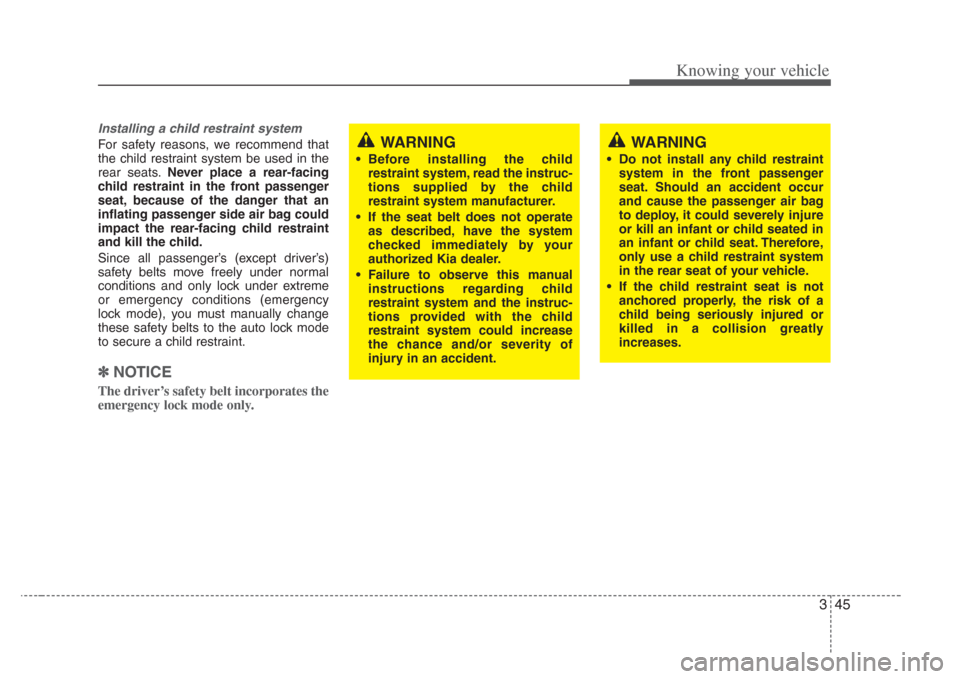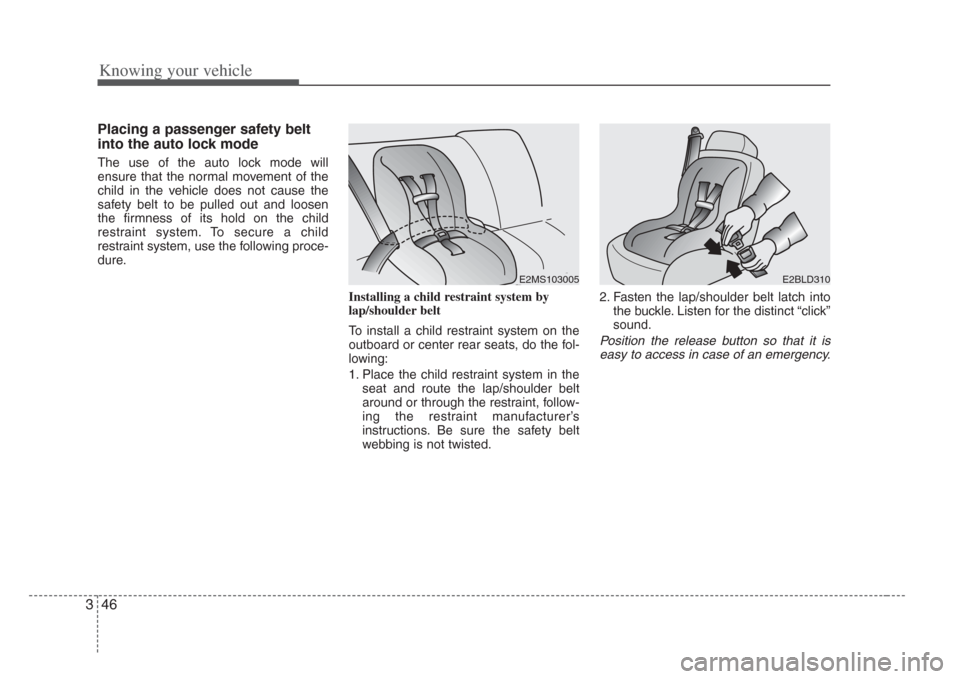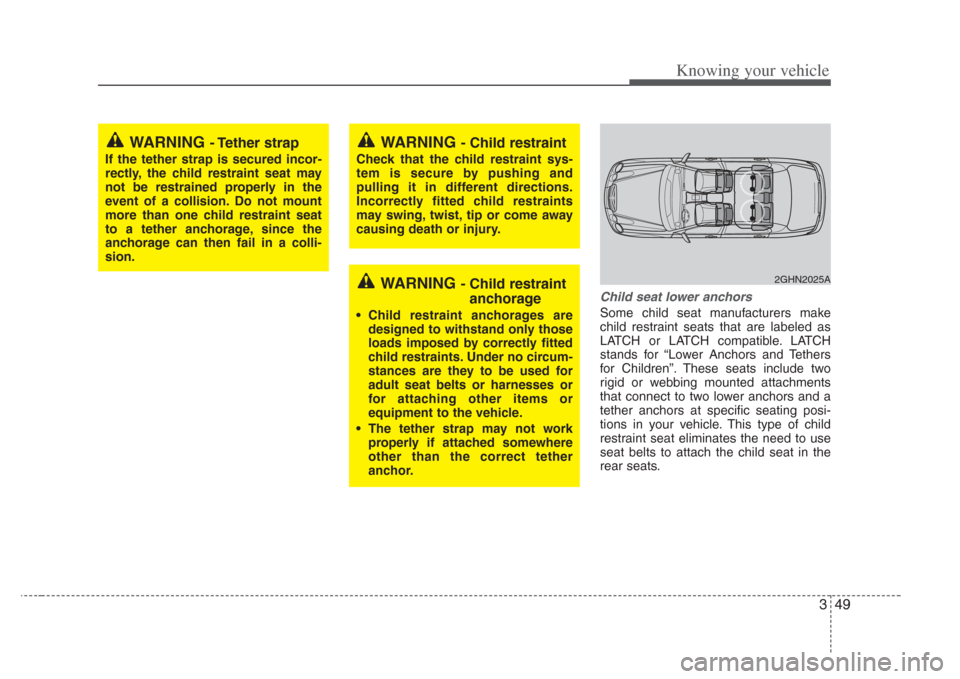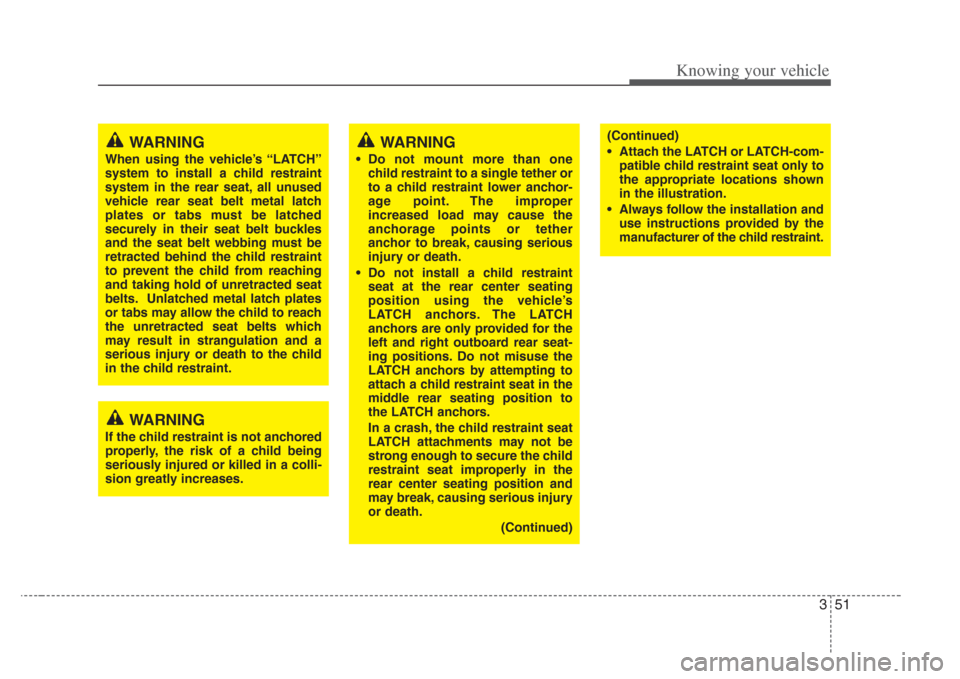2008 KIA Amanti ECU
[x] Cancel search: ECUPage 55 of 283

345
Knowing your vehicle
Installing a child restraint system
For safety reasons, we recommend that
the child restraint system be used in the
rear seats.Never place a rear-facing
child restraint in the front passenger
seat, because of the danger that an
inflating passenger side air bag could
impact the rear-facing child re straint
and kill the child.
Since all passenger’s (except driver’s)
safety belts move freely under normal
conditions and only lock under extreme
or emergency conditions (emergency
lock mode), you must manually change
these safety belts to the auto lock mode
to secure a child restraint.
✽ NOTICE
The driver’s safety belt incorporates the
emergency lock mode only.
WARNING
• Do not install any child restraint
system in the front passenger
seat. Should an accident occur
and cause the passenger air bag
to deploy, it could severely injure
or kill an infant or child seated in
an infant or child seat. Therefore,
only use a child restraint system
in the rear seat of your vehicle.
• If the child restraint seat is not
anchored properly, the ri sk of a
child being seriously injured or
killed in a collis ion greatly
increases.
WARNING
• Before ins talling the child
restraint system, read the instruc-
tions supplied by the child
restraint system manufacturer.
• If the seat belt does not operate as described, have the system
checked immediately by your
authorized Kia dealer.
• Failure to observe this manual ins tructions regarding child
restraint system and the instruc-
tions provided with the child
restraint system could increase
the chance and/or s everity of
injury in an accident.
Page 56 of 283

Knowing your vehicle
463
Placing a passenger safety belt
into the auto lock mode
The use of the auto lock mode will
ensure that the normal movement of the
child in the vehicle does not cause the
safety belt to be pulled out and loosen
the firmness of its hold on the child
restraint system. To secure a child
restraint system, use the following proce-
dure.
Installing a child restraint system by
lap/shoulder belt
To install a child restraint system on the
outboard or center rear seats, do the fol-
lowing:
1. Place the child restraint system in theseat and route the lap/shoulder belt
around or through the restraint, follow-
ing the restraint manufacturer’s
instructions. Be sure the safety belt
webbing is not twisted. 2. Fasten the lap/shoulder belt latch into
the buckle. Listen for the distinct “click”
sound.
Position the release button so that it iseasy to access in case of an emergency.
E2MS103005E2BLD310
Page 58 of 283

Knowing your vehicle
483
✽NOTICE
When the safety belt is allowed to
retract to its fully stowed position, the
retractor will automatically switch from
the “Auto Lock” mode to the emergency
lock mode for normal adult usage.
Securing a child re straint seat with
“Tether Anchor” system
Child restraint hook holders are located
on the shelf behind the rear seats.
1. Open the tether anchor cover on the
shelf behind the rear seats. 2. Route the child restraint seat strap
over the seatback.
For vehicles with adjustable headrest,
route the tether strap under the head-
rest and between the headrest posts,
otherwise route the tether strap over
the top of the seatback.
3. Connect the tether strap hook to the correct child restraint hook holder and
tighten to secure the seat.
WARNING- Auto lockmode
The lap/shoulder belt automatically
returns to the “emergency lock
mode” whenever the belt i s allowed
to retract fully. Therefore, the pre-
ceding seven steps mu st be fol-
lowed each time a child re straint is
installed.
If the s afety belt is not placed in the
“auto lock” mode, severe injury or
death could occur to the child
and/or other occupants in the vehi-
cle in a collis ion,since the child
res traint will not be effectively held
in place.
6GHA2025OGH036330N
Page 59 of 283

349
Knowing your vehicle
Child seat lower anchor s
Some child seat manufacturers make
child restraint seats that are labeled as
LATCH or LATCH compatible. LATCH
stands for “Lower Anchors and Tethers
for Children”. These seats include two
rigid or webbing mounted attachments
that connect to two lower anchors and a
tether anchors at specific seating posi-
tions in your vehicle. This type of child
restraint seat eliminates the need to use
seat belts to attach the child seat in the
rear seats.
WARNING - Tether strap
If the tether strap is secured incor-
rectly, the child restraint seat may
not be restrained properly in the
event of a collision. Do not mount
more than one child re straint seat
to a tether anchorage, since the
anchorage can then fail in a colli-
sion.
2GHN2025A
WARNING - Child restraint
Check that the child restraint sys-
tem is secure by pus hing and
pulling it in different directions .
Incorrectly fitted child res traints
may swing, twist, tip or come away
causing death or injury.
WARNING - Child restraint anchorage
• Child res traint anchorages are
designed to withstand only tho se
loads imposed by correctly fitted
child restraints. Under no circum-
stances are they to be used for
adult seat belts or harnesses or
for attaching other items or
equipment to the vehicle.
• The tether strap may not work
properly if attached somewhere
other than the correct tether
anchor.
Page 61 of 283

351
Knowing your vehicle
WARNING
If the child restraint is not anchored
properly, the risk of a child being
seriously injured or killed in a colli-
sion greatly increases.
WARNING
When using the vehicle’ s “LATCH”
system to install a child restraint
system in the rear seat, all unused
vehicle rear seat belt metal latch
plates or tabs must be latched
securely in their seat belt buckles
and the seat belt webbing mu st be
retracted behind the child re straint
to prevent the child from reaching
and taking hold of unretracted seat
belts. Unlatched metal latch plate s
or tabs may allow the child to reach
the unretracted seat belts which
may result in strangulation and a
serious injury or death to the child
in the child restraint.
WARNING
• Do not mount more than one child restraint to a single tether or
to a child restraint lower anchor-
age point. The improper
increas ed load may caus e the
anchorage points or tether
anchor to break, causing serious
injury or death.
• Do not install a child restraint seat at the rear center seating
pos ition us ing the vehicle’ s
LATCH anchor s. The LATCH
anchor s are only provided for the
left and right outboard rear seat-
ing positions. Do not mi suse the
LATCH anchor s by attempting to
attach a child restraint seat in the
middle rear seating position to
the LATCH anchor s.
In a crash, the child restraint seat
LATCH attachment s may not be
strong enough to secure the child
restraint seat improperly in the
rear center seating position and
may break, causing serious injur
y
or death.
(Continued)
(Continued)
• Attach the LATCH or LATCH-com-patible child restraint seat only to
the appropriate location s shown
in the illustration.
•Alway s follow the installation and
use instructions provided by the
manufacturer of the child res traint.
Page 75 of 283

365
Knowing your vehicle
Curtain air bag
Curtain air bags are located along both
sides of the roof rails above the front and
rear doors.
It is designed to help protect the heads of
the front seat occupants and the rear out-
board seat occupants in certain side
impact collisions.• The curtain air bag deployment occurs
only on the side of the vehicle affected
by the impact.
• The side air bags (side and curtain air bags) are not designed to deploy dur-
ing collisions from the front or rear of
the vehicle or in most rollover situa-
tions.
• The curtain air bags are designed to deploy only during certain side-impact
collisions, depending on the crash
severity, angle, speed and impact. The
curtain air bags are not designed to
deploy in all side impact situations.
WARNING
• In order for side air bags ( side
and curtain air bag s) to provide
best protection, both front seat
occupants and both outboard
rear occupants should sit in an
upright pos ition with the s eat
belts properly fas tened.
Importantly, children should sit in
a proper child restraint system in
the rear seat.
(Continued)
(Continued)
• When children are seated in the
rear outboard seats, they must be
s eated in the proper child
restraint system. Make sure to put
the child restraint system as far
away from the door side as possi-
ble, and securely lock the child
restraint system in position.
• Do not allow the pa ssengers to
lean their head s or bodies onto
door s, put their arms on the
door s,stretch their arms out of
the window, or place objects
between the door s and passen-
ger s when they are seated on
s eats equipped with s ide air
bags.
• Never try to open or repair any components of the side curtain
air bag system.
This should only
be done by an authorized Kia
dealer.
Failure to follow the above men-
tioned ins tructions can res ult in
injury or death to the vehicle occu-
pants in an accident.
2GHA2125
2GHA2125A
Page 83 of 283

373
Knowing your vehicle
Installing a child restraint on a
front passenger’ s seat is forbid-
den.
Never place a rear-facing child restraint
in the front passenger’s seat. If the air
bag deploys, it would impact the rear-fac-
ing child restraint, causing serious or
fatal injury.
In addition, do not place front-facing
child restraint in the front passenger’s
seat either. If the front passenger air bag
inflates, it would cause ser ious or fatal
injuries to the improperly positioned or
improperly restrained child.
Air bag warning light
The purpose of the air bag warning light in
your instrument panel is to alert you of a
potential problem with your air bag -
Supplemental Restraint System (SRS).
When the ignition switch is turned ON,
the indicator light should blink or illumi-
nate for approximately 6 seconds, then
go off.
Have the system checked if:
• The light does not turn on briefly when you turn the ignition ON.
• The light stays on after the engine starts.
• The light comes on while the vehicle is in motion.
ADAIRBAG
AIR
BAG
WARNING
• Never put child restraint in the front passenger’ s seat. If the front
passenger air bag inflates ,it
would caus e serious or fatal
injuries.
• When children are seated in the rear outboard seats in which side
air bags are equipped, be sure to
put the child restraint system as
far away from the door side as
possible, and securely lock the
child restraint system in position.
Inflation of side or curtain air bag
could caus e serious injury or
death due to the expans ion
impact.
Page 87 of 283

377
Knowing your vehicle
Trunk room lamp
Trunk room lamp turns on when the trunk
is opened. It remains on until the trunk is
securely closed.
Inside the vehicle
To open the trunk from inside the vehicle,
make sure the trunk lid control button in
the glove box is ON, then pull the trunk
lid release switch (
➀) on the driver’s door
panel.
If the trunk lid control button in the glove
box is OFF, the trunk can only be opened
with the vehicle master key.
WARNING-Exhaust
fumes
If you drive with the trunk lid open,
you will draw dangerou s exhaust
fumes into your vehicle cau sing
serious injury or death to vehicle
occupants. Open trunk lid s can
also dangerously ob scure rear view
vision.
If you must drive with the trunk lid
open, keep the air vents open so
that additional outside air come s
into the vehicle.
1GHA2018
CAUTION
Make sure to clos e the trunk
securely. If it remains open while the engine i s not running, it may
cause battery discharge because the trunk room lamp remains on.
1GHA2019